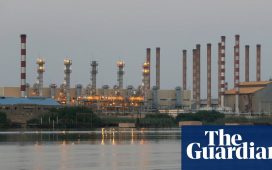LONDON (Reuters) – Oil rose on Wednesday following media reports that China was open to agreeing a partial trade deal with the United States, while unrest in OPEC members Iraq and Ecuador also supported prices.
FILE PHOTO: Crude oil storage tanks are seen from above at the Cushing oil hub, in Cushing, Oklahoma, March 24, 2016. REUTERS/Nick Oxford/File Photo
Brent crude LCOc1 was up 65 cents at $58.89 a barrel by 1016 GMT, and U.S. West Texas Intermediate crude CLc1 was at $53.19, up 56 cents. Both gained more than 1%.
Negotiators from the United States and China, the world’s top two economies, will meet in Washington on Thursday in the latest effort to hammer out a deal aimed at ending a long-running trade dispute that has slowed global growth.
Tensions between the two sides rose this week as the United States imposed visa restrictions on Chinese officials and placed some major Chinese companies on a blacklist.
China is still open to agreeing a partial trade deal, Bloomberg reported on Wednesday, citing an official with direct knowledge of the talks.
The Financial Times also reported, quoting an unnamed source, that China was offering to increase annual purchases of U.S. agricultural products as part of efforts to secure an interim trade agreement with Washington.
“Crude oil has, just like other riskier assets, received a boost from news that China is open to accept a partial trade deal,” Saxo Bank commodity strategist Ole Hansen said.
“This news comes on top of earlier reports that Turkish troops have moved into Iraq – something that could add to a growing list of geopolitical worries for the oil market.”
Turkey said on Wednesday its forces would cross the Syrian border shortly, launching attacks that analysts say could impact the economy of the oil-producing Kurdistan region in Iraq, and energy prices.
Anti-government protests also threatened oil production in Ecuador and Iraq, members of the Organization of the Petroleum Exporting Countries.
Saudi Aramco Chief Executive Amin Nasser said on Wednesday there was no doubt Iran was behind September’s attacks on Saudi oil facilities, and warned such strikes may continue if there is no concerted international response.
In the United States, meanwhile, crude stockpiles rose by 4.1 million barrels in the week ended Oct. 4 to 422 million, data from the American Petroleum Institute showed. Analysts had expected an increase of 1.4 million barrels. [EIA/S]
Weekly inventory data from the U.S. government’s Energy Information Administration (EIA) is due at 10:30 a.m. EDT (1430 GMT) on Wednesday.
The EIA said U.S. crude production was expected to rise by 1.27 million barrels per day in 2019 to a record 12.26 million bpd.
Adiotional reporting by Florence Tan in Singapore; Editing by Dale Hudson












